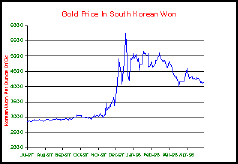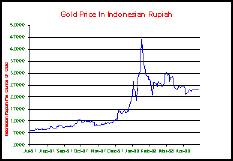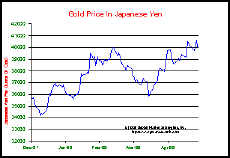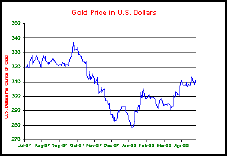Gold in a Deflationary Economy - Part- XI
If you're in Asia, you're already "enjoying" a bull market in gold, although I must note that the word "enjoy" may not be very appropriate since many are struggling to survive the bursting of the speculative bubble. Nonetheless, for those have been holding gold their operational wealth has been all but preserved since gold skyrocketed in terms of Asian currency, reflecting more the collapse of their respective currencies than bullish fundamentals for gold. However, it's all relative, so to speak, and fundamentals for gold have, in fact, been bullish in Asia even while bearish in the western world. As a result, I feature the charts of gold in terms of Asian currency on this page, since it depends upon where one lives as to whether or not gold is bullish or bearish, and whether or not inflation or deflation is occurring.
ASSET PRICE DEFLATION AND SIMULTANEOUS CURRENCY INFLATION
It seems like inflation, but it's really a symptom of deflation in a fiat currency system. If you're in Indonesia or other parts of the Pacific Rim, asset price deflation (i.e., stock market and real estate collapses) has already led to soaring gold prices in terms of local currency. In Indonesia, gold soared 325% in a short three months before settling back to a "mere" 100% gain. Very suddenly and dramatically, to those not holding gold the cost of everyday goods and services soared to unaffordable levels. For Indonesians holding gold when the severe bout of asset price deflation began to grip the Pacific Rim in 1997, the 575% increase in the price of gold in terms of Indonesian Rupiah resulted in a gain in operational wealth between July 1997 and January 1998.
Put a different way, if you lived in Indonesia and held gold you maintained your operational wealth relative to the rest of the globe while your neighbors not holding gold suffered an 83% collapse in operational wealth. South Korea and some other Pacific Rim countries experienced a similar fate, while Japanese consumers holding gold are gaining operational wealth at a less dramatic rate. Meanwhile, gold was steadily declining against the U.S. dollar, further dramatizing the benefits of holding gold in the Pacific Rim.


This all means that the people of the Asian economies that collapsed beginning in 1997 are truly being torn in both directions by inflation and deflation-both at the same time! How can this be? It seems the Decade of Currency has struck again, for the soaring prices of goods in Asia is due to the collapse of their respective currencies, meaning that US$100 worth of goods in 1998 costs perhaps 10,000 Indonesian Rupiah now, whereas on January 1 1997 before the crisis accelerated that same basket of US$100 worth of goods cost only 3,000 Rupiah. That's a serious round of inflation when a basket of goods costs nearly three times what it costs only a year earlier.
But the other side of the Asian coin is the severe asset price deflation and monetary deflation of the truest kind. Were the global economy already on a gold standard, the people of Asia would not also be experiencing a currency collapse to compound the problem. This is not to imply that the gold standard is a panacea, but the Decade of Currency has truly hit consumers as forecast in The Global Market Strategist in that the present fiat currency system is exacerbating other economic problems and will for some time to come. In fact, it appears that this system will exacerbate the global recession (depression in many areas) due to the fiat currency system.
Holders of gold were able to avert the severe loss of operational wealth, though. One might argue that those holding U.S. dollars during the crisis preserved operational wealth, too, and that is true but it represents only a short-term perception of the situation. Later, the U.S. dollar will have its fiat status tested and one would expect to lose operational wealth then, too. Moreover, if gold, in fact, enters a new bull market versus the dollar, the U.S. currency will lose purchasing power and holders of dollars will begin to lose operational wealth. There is simply and positively no better store of value over the centuries than gold.


Moreover, Asia may be giving us a peek at what would happen to gold flows not only during a currency collapse, but if the global economy were, in fact, to move to a form of the gold standard as we have forecast will occur in one form or another. Out of necessity, South Korean citizens began to turn their gold over to their government in an effort to stem the liquidity crisis there generated by insufficient currency or gold reserves (the South Korean Treasury had insufficient quantities of both). By turning the gold over to the government, part of the currency collapse was offset since gold has been holding its value (yet another illustration of the golden constant) and the government was in effect reaccumulating gold reserves.
Our monthly market letter, The Global Market Strategist ®, has observed that the temporary oversupply of gold on the world markets due to the central banks of many countries selling down their gold reserves will not only abate but will turn into a situation of undersupply when these central banks scramble to reaccumulate reserves to attempt to stabilize volatile or collapsing fiat currencies, and perhaps to prepare to move back to a gold standard or fractional gold reserve system.
















